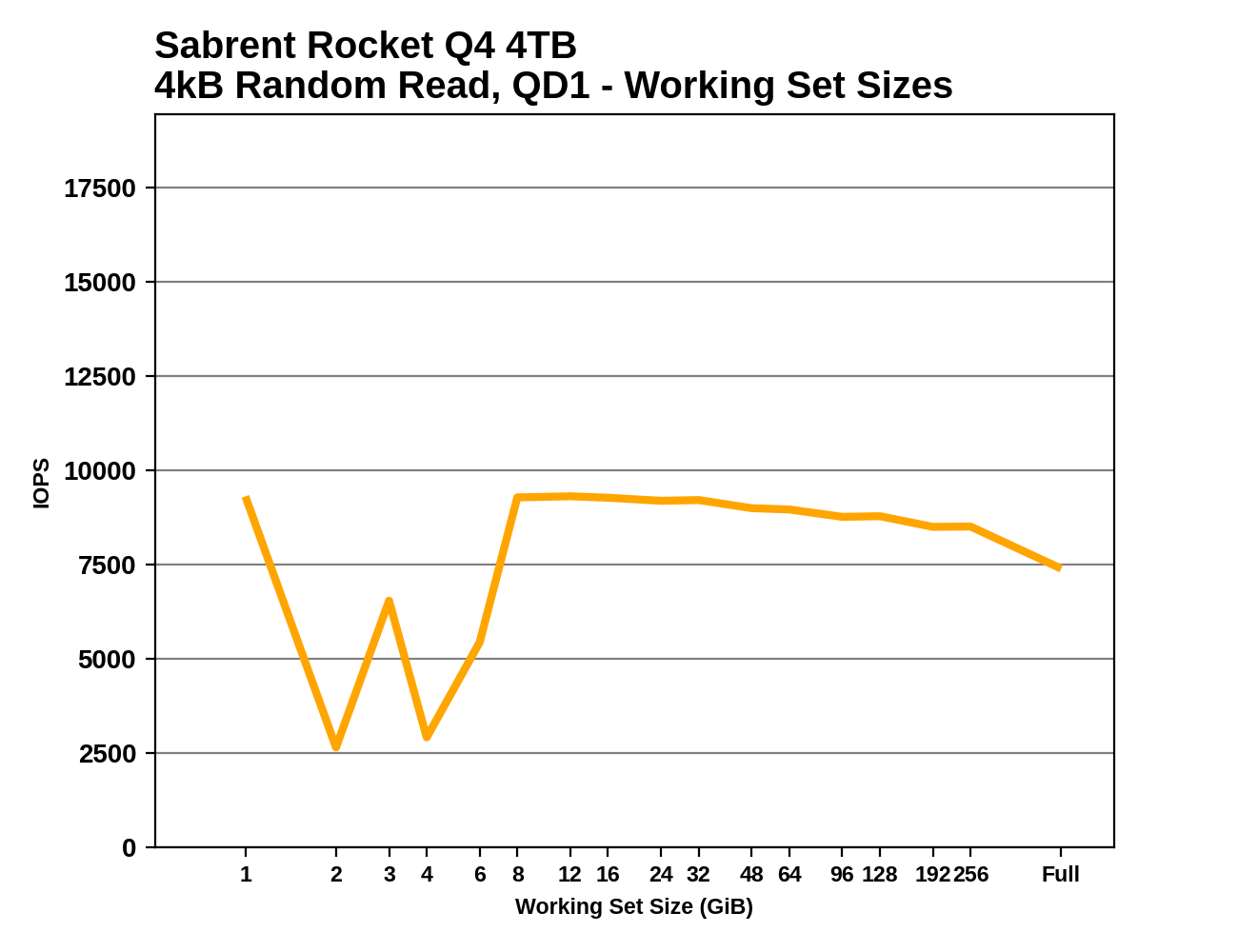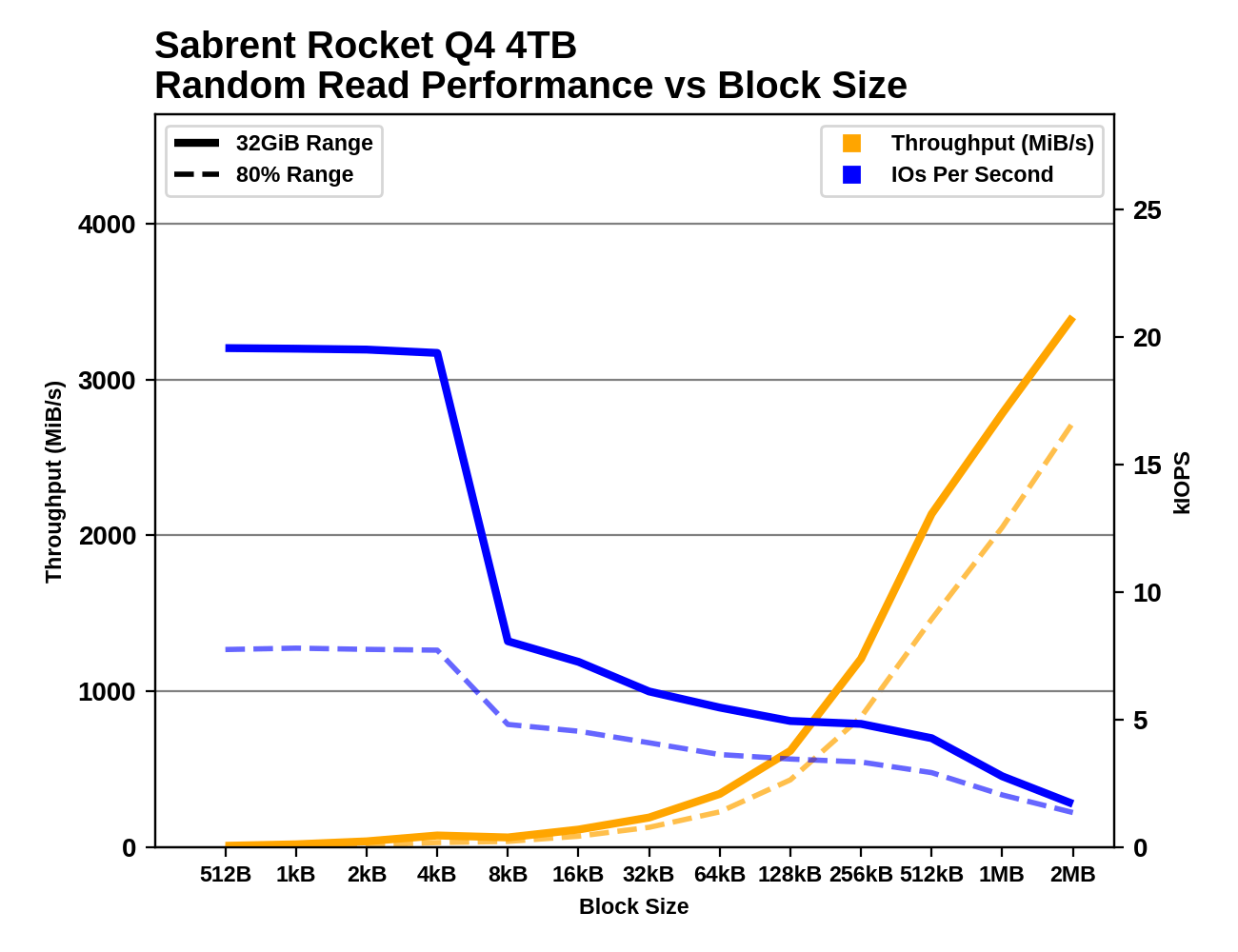Sabrent Rocket Q4 and Corsair MP600 CORE NVMe SSDs Reviewed: PCIe 4.0 with QLC
by Billy Tallis on April 9, 2021 12:45 PM ESTAdvanced Synthetic Tests
Our benchmark suite includes a variety of tests that are less about replicating any real-world IO patterns, and more about exposing the inner workings of a drive with narrowly-focused tests. Many of these tests will show exaggerated differences between drives, and for the most part that should not be taken as a sign that one drive will be drastically faster for real-world usage. These tests are about satisfying curiosity, and are not good measures of overall drive performance. For more details, please see the overview of our 2021 Consumer SSD Benchmark Suite.
Whole-Drive Fill
 |
|||||||||
| Pass 1 | |||||||||
| Pass 2 | |||||||||
As is typical for QLC drives based around Phison controllers, the SLC caches on the Rocket Q4 and MP600 CORE are as large as possible: about 1/4 the usable capacity of the drive. Write speeds to the cache hover around or just above the limit of what a PCIe 3 x4 link could handle, and once the cache is full performance drops down to well below the limit of what a SATA link could handle.
 |
|||||||||
| Average Throughput for last 16 GB | Overall Average Throughput | ||||||||
Both the 2TB MP600 CORE and the 4TB Rocket Q4 have about the same overall write speed, and they're in the middle of the pack of QLC drives: the older 8TB Rocket Q and the more recent Intel 670p both outperform the Phison E16 drives. And all of the TLC drives naturally sustain higher write speeds than any of these QLC drives.
Working Set Size
 |
|||||||||
Both the Rocket Q4 and MP600 CORE have some disappointing performance drops during the working set size test, suggesting there's background work keeping the drives busy despite all the idle time they get before the test and between phases of the test. But aside from that, we see the expected trends: the MP600 CORE has flat overall performance on account of having 2GB of DRAM for its 2TB of NAND, while the Rocket Q4 shows a slight performance decline for large working sets because it's managing 4TB of NAND with the same 2GB of DRAM.
Performance vs Block Size
 |
|||||||||
| Random Read | |||||||||
| Random Write | |||||||||
| Sequential Read | |||||||||
| Sequential Write | |||||||||
The two Phison E16 drives with QLC show similar patterns to the E12 QLC drives, but with substantial performance improvements in several places, most notable for random reads. These drives don't have any issues with block sizes smaller than 4kB, but there are performance drops at larger block sizes where the SLC cache runs out while testing random writes.










60 Comments
View All Comments
allenb - Sunday, April 11, 2021 - link
This whining about QLC is an amazing mix of comedy and incompetence. Who cares about the storage medium? If your data is written to petrified goose excrement, what does it matter if the delivered performance meets your needs?Faceless corporations screw us over in plenty of legitimate ways. Why make up new things to get pissed off about?
Do the math or look at your actual usage data. Very few individuals are generating enough write traffic for endurance to be a concern. As others have stated here.
JoeDuarte - Sunday, April 11, 2021 - link
Bugs and bad software developers can cause significant degradation of SSD endurance. There was a bug in the Spotify desktop app a couple of years ago that caused massive writes, way beyond normal use, which affected SSD owners the most.And there are apparently issues with Apple's M1 Macbooks, though I haven't kept up. It might have been related to their stingy RAM allotment (8 GB), causing excessive SSD swap.
Endurance will matter when it's as bad as these drives, which is the worst I've ever seen.
Oxford Guy - Tuesday, April 13, 2021 - link
Probably nanosecond timestamps in APFS with various spyware running amok.edzieba - Monday, April 12, 2021 - link
Oh shush, next you'll be telling them that bus interface speed or heatsink presence/size is not an useful indicator of drive performance!ZolaIII - Friday, April 16, 2021 - link
Sure take an example of guy who likes to watch the movies on it's new TV. He whatches 50 movie a month. He takes 4K Blue-ray discs but wants to convert them to 4K HDR + HLG (H265 10 Bit HLG+) format to match the display capabilities as good as possible. In order to do that in real time he uses GPU conversion and as it sucks regarding quality he puts 2x higher bit rate doing so. Of course he first copy them to SSD. That's (50x50) GB x3 = 7.32 TB per month or almost 88 TB per year for one or two muvies every day. When you add rest it comes to at least 100 TB a year. Example is realistic with not to much or extensive usage and illustration of how QLC endurance simply is concerning.FunBunny2 - Saturday, April 17, 2021 - link
"almost 88 TB per year for one or two muvies every day. When you add rest it comes to at least 100 TB a year."well... such a knucklehead obviously doesn't have any time devoted to work, so s/he's either a rich real estate developer or a welfare queen/king. :)
ZolaIII - Sunday, April 18, 2021 - link
Why? If you work from 9 to 5 you don't have time to watch a movie or two (especially if you like watching movies)?DracoDan - Monday, April 19, 2021 - link
They should sell a single SSD that can be user configured as a 4TB QLC, 2TB TLC, 1TB MLC, or 512GB SLC SSD. That way the end user has the ability to decide the tradeoff for space vs performance!Billy Tallis - Tuesday, April 20, 2021 - link
Your math is off, possibly because of the common misunderstanding of the difference between the number of bits stored per memory cell and the number of possible voltage states required to represent those bits.It would be 4TB as QLC, 3TB as TLC, 2TB as MLC or 1TB as SLC. See the Whole-Drive Fill test which illustrates that the 4TB drive has up to 1TB of SLC cache.
xJumpManx - Monday, May 3, 2021 - link
If you have a X570 Taichi do not buy sabrent ssd the mobo does not detect the drive.